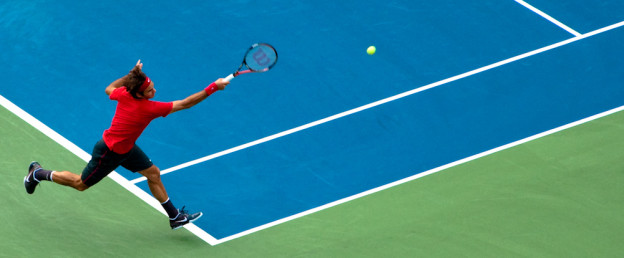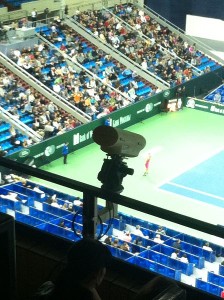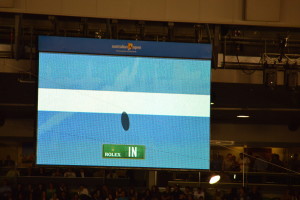Tennis and Hawk-Eye are two things that inherently belong together but it was not like this all the time. Hawk-Eye is quite new invention that plays a huge part in tennis as we know it.
Majority of tennis players in the past were at least once in a lifetime furious about some of the calls made by line referee or an umpire. There were huge disputes whether the ball was inside of the court or outside of the circumscribed area. These disputes led to innovation called Hawk-Eye. As the time passed Hawk-Eye was spread to all three tennis tours, which are WTA for women, ATP for men and ITF that is for both genders. Since the Hawk-Eye plays a big role in the world of tennis, from now on there is no possibility for any type of disputes about the calls made by officials.
Hawk-Eye also known as electronic review or simply “challenge” is camera-based computer system that is designed to measure the ball trajectory and the place where the ball landed. This system uses ten high-speed cameras, with speed of 60-70 frameworks per second, that are spread all around the tennis courts (Tennis Hawk Eye – What is it and how does it work). Each camera tracks every ball, since the first point of the match till the end of the match, despite the fact if it is really of fifty shots or just one ace. Hawk-Eye technology will capture all the information for every shot such as speed, angle, direction and mark. All records are put to one 3D movable picture. “This is done irrespective of whether a player challenges a call. Each point is assessed to check all 10 cameras are doing their job. If a player does challenge, the answer to the queried call pops up on a screen, for example “20mms in” and the visual replay is ready to be displayed on the big screen five to 10 seconds after the call was made.” (Inside Hawkeye)
When electronic review was introduced in tennis between the season of 2002 and 2003 there were many different reactions from players (The History of Hawkeye). Some players disagree with the usage of electronic review whether some players strongly urges to spread Hawk-Eye technology to every tournament. At the moment Hawk-Eye technology is used at high-category tournaments such as Grand Slams, Masters (ATP), Premier (WTA), Davis Cup and Fed Cup (ITF).
Until 2008 rules for using Hawk-Eye differed tournament to tournament. Some organizators allowed infinite number of “challenges” but on the other hand some tournament directors allowed just two “challenges” per set. “From March 19, 2008 forward a unified rule of three unsuccessful challenges per set, with an additional challenge if the set reaches a tiebreak, is in force.” Moreover the rules says that electronic review can be used on every approved surface, except clay where the ball mark is clearly visible and checked by the umpire. (Tennis Hawk Eye – What is it and how does it work). This means that a player can have infinite number of “challenges” that are correct but if the player is incorret three times per set, he or she is not anymore allowed to ask for electronic review during the same set.
According to Brett Zarda and Sarah Edworthy, 30 to 40% of challenges from players are correct (This means that the official was wrong and the player was right.) and that they are more likely to ask for “challenge” towards the end of the match. This support the fact that line umpires are still necessary for tennis.
Even though it is computer-based technology there are still some disputes about the accuracy of Hawk-Eye. It is said that this system has accuracy of 3-4 millimeters. For example, accuracy decreases with increase of dark (Brett Zarda). But we can see huge development of Hawk-Eye since it’s begging. It is said that Hawk-Eye accuracy is about 99%.
The major advantages of Hawk-Eye are accuracy, minimizing of human error in decision making and that it reassures players. On the other hand, Hawk-Eye is quite expensive (€ 33000 per week). Another disadvantage is that the system needs complex arrangements. This means that it needs to be prepared one week before a tournament. Moreover one system on one tennis court needs at least four people involved: two Hawk-Eye people, one big-screen operator (screen which spectators and players see) and one review official (Sarah Edworthy).
In conclusion, this era of tennis is strongly attached to Hawk-Eye technology. Further expansion of Hawk-Eye will influence tennis even more. It will spread to more tournaments and ensure fair play. In my opinion, it is quite useful for tennis because electronic review can really influence whole match or duration of match. Moreover it is more attractive for spectators and televiewers.
Sources:
Edworthy, Sarah. „A Day in the Life: Hawk-Eye.“ – The Championships, Wimbledon 2016. N.p., July 2007. Web. 14 Dec. 2015.
„Inside Hawkeye.“ YouTube. Australian Open TV, Jan. 2012. Web. 14 Dec. 2015.
„Tennis Hawk Eye – What Is It and How Does It Work? – World Sports Intelligence.“ World Sports Intelligence. N.p., 30 Oct. 2012. Web. 14 Dec. 2015.
„The History of Hawkeye.“ Pi in the Sky. N.p., Jan. 2015. Web. 14 Dec. 2015.Distribution of high-speed cameras around the court.
Zarda, Brett. „Instant Replay.“ Popular Science. N.p., Sept. 2008. Web. 14 Dec. 2015.
Picture 1: https://www.flickr.com/photos/29071316@N06/6388671179
Picture 2: https://commons.wikimedia.org/wiki/File:Kremlin_Cup_2012_-_Hawk-Eye_cam.JPG
Picture 3: https://flic.kr/p/Axq15d



